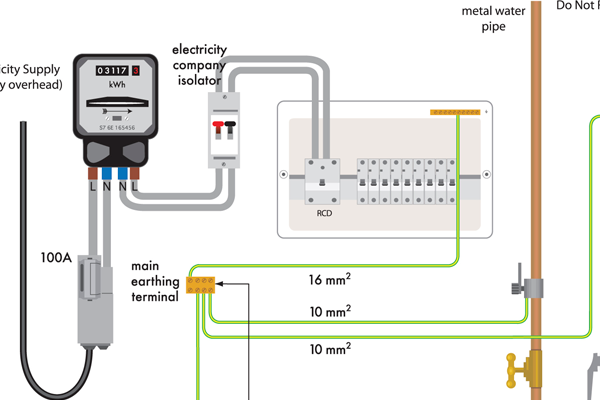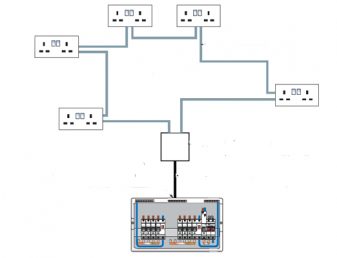Earthing and bonding are two very different, but often confused, methods of preventing electric shock.
The principal of earthing is to limit the duration of touch voltages if you were to make contact with an exposed conductive part. The earth creates a safe route for the current to flow instead of causing electric shock.
The purpose of bonding is to reduce the risk of electric shock if you find yourself touching separate metallic parts when there is a fault somewhere within the electrical installation. Protective bonding conductors reduce the magnitude of touch voltage in this scenario.
Earthing and bonding are both an essential requirement of any electrical installation and covered within the safety requirements of BS7671.
What is an earthing system?
At its simplest, an earthing system is the arrangement by which an electrical installation is connected to a means of earthing. This is usually for safety purposes although sometimes also for functional purposes, for example in the case of telegraph lines which use the earth as a conductor to save the cost of a return wire over a long circuit. If there is a fault in an electrical installation, a person could get an electric shock by touching a live metal part, because electricity uses the body as a path to the earth. Earthing provides an alternate path for a fault current to flow to earth.
There are three main earthing systems in the UK used for non-specialist installations and defined in the IET Wiring Regulations, two are TN systems (where the distribution network operator (DNO) is responsible for earthing) and the other is a TT system (which does not have its own earth connection):
Key: T = Terre (earth), N = neutral, C = combined, S = separate
- TN-S
TN-S systems have a single neutral-to-earth connection, placed as near as possible to the supply transformer and separate supply cables throughout. In low voltage supplies the transformer can even be connected to the sheath of the supply cable which will give a separate route back to the sub-station transformer. The DNO’s maximum external earth fault loop impedance in these configurations is normally 0.8 Ω.

- TN-C-S
This is the most common configuration used in the UK. It can also be known as protective multiple earthing (PME) and provides low voltage supply with reliable and safe earthing. This system allows multiple users to utilise one supply cable. The resultant rise in current flow creates a voltage rise in the protective earthed neutral (PEN) which needs multiple connection to earth along the supply route. The neutral is earthed close to the source of supply, at the intake of the installation and at necessary points throughout the distribution system. As the DNO uses a combined neutral and PEN return path the maximum external earth fault loop impedance is 0.35 Ω.
Despite its popularity, the TN-C-S arrangement could prove hazardous if the PEN conductor becomes an open circuit in the supply because the current would not have an immediate path back to sub-station level. Because of this, there are certain installations where it is not allowed to be used – including petrol stations, building sites, caravan parks and some outbuildings.

- TT
This is configured in a similar way to the TN-S system but doesn’t give consumers their own individual earth connection. Instead, consumers must supply their own earth, for example by burying rods or plates underground to provide a path of low impedance. Often TT systems are used where TN-C-S arrangements can’t be (eg in the petrol station example above) or in rural areas where supply is provided on overhead poles. Shock protection measures such as RCDs are often used to provide automatic disconnection of supply where different soil types that may cause external earth fault loop impedance values exist.

What is bonding?
Electrical bonding is the practice of connecting all exposed metallic items not designed to carry electricity in an area by using a protective bonding conductor and aims to protect people who may touch two separate metal parts from electric shock in case of an electrical fault. It reduces the voltage that might have been there.
As mentioned previously, it can be confusing knowing when an item should be earthed and when it should be bonded.
As an example, let’s take a metallic cable tray, which is often found in an electrical installation. If:
- The tray is an exposed-conductive-part (ie it can be touched and isn’t normally live) it WILL need to be earthed.
- The tray is an extraneous-conductive-part (ie the ohmic value between the suspected extraneous part and Earth is less than 22 kΩ) it WILL need to be bonded.
- The tray is neither an exposed or extraneous-conductive-part then it WON’T need to be either earthed or bonded.
Find out more about how to identify an extraneous-conductive-part here.






